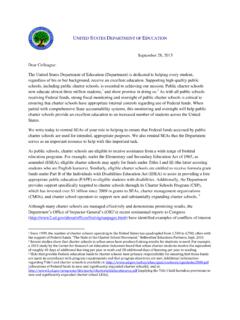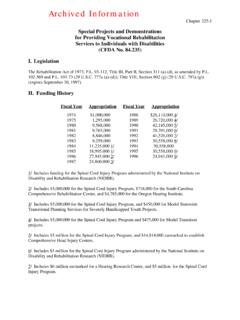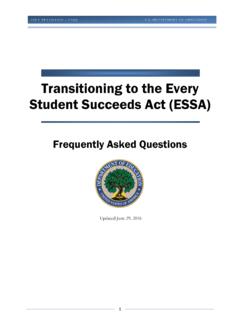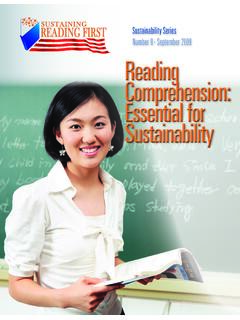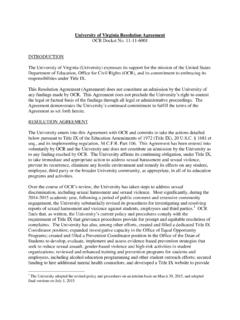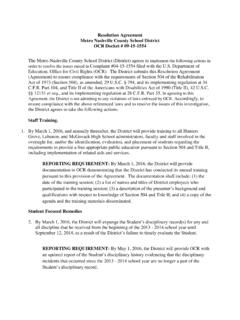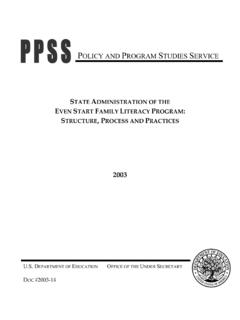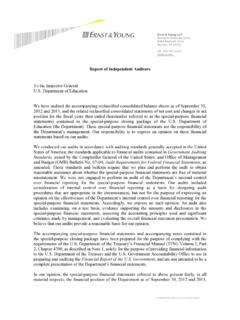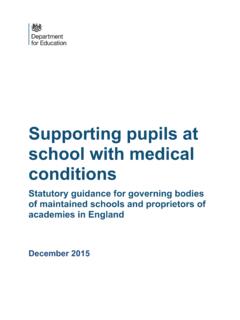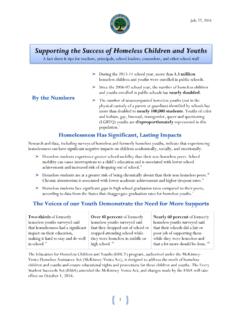Transcription of Supporting Child and Student Social, Emotional, Behavioral ...
1 Supporting Child and Student Social, Emotional, Behavioral , and Mental Health Needs Department of Education Dr. Miguel A. Cardona Secretary of Education Office of Special Education and Rehabilitative Services Katherine Neas Acting Assistant Secretary This report is in the public domain. Authorization to reproduce it in whole or in part is granted. While permission to reprint this publication is not necessary, the citation should Department of Education, Office of Special Education and Rehabilitative Services, Supporting Child and Student Social, Emotional, Behavioral , and Mental Health Needs, Washington, DC, 2021. This report is available on the Department's website at Availability of Alternate Formats On request, this publication is available in alternate formats, such as Braille or large print.
2 For more information, please contact the Department's Alternate Format Center at 202-260-0818 or via e-mail at Notice to Limited English-Proficient Persons If you have difficulty understanding English, you may request language assistance services for Department information that is available to the public. These language assistance services are available free of charge. If you need more information about interpretation or translation services, please call 1-800-USA-LEARN (1-800-872-5327). (TTY: 1-800-877-8339), email us at or write to Department of Education, Information Resource Center, 400 Maryland Ave., SW, Washington, DC 20202. DISCLAIMERS. Other than statutory and regulatory requirements included in the document, the contents of this document do not have the force or effect of law and are not meant to bind the public.
3 This document is intended only to provide clarity to the public regarding existing requirements under the law or agency policies. This document is intended as a resource on social, emotional, and Behavioral supports and other mental health services for children and students. Further, with the exception of brief references to students with disabilities as a subgroup, this document does not provide specific guidance on Federal disability laws, which include requiring schools to provide for the education of students with disabilities and to take an individualized approach to providing services, consistent with the Student 's individualized education program (IEP) developed under Part B of the Individuals with Disabilities Education Act (IDEA) or plan developed under Section 504 of the Rehabilitation Act of 1973 (hereafter, Section 504 and 504 plan), as appropriate.
4 A summary of legislative and policy resources related to the social, emotional, and Behavioral supports and mental health services in the Elementary and Secondary Education Act (ESEA), IDEA, and Section 504 are provided in Appendix D. For information on these programs, the rights of children and students with disabilities and schools'. obligations under those Federal laws, please refer to information provided by the Department of Education's Office of Safe and Supportive Schools in the Office of Elementary and Secondary Education; Office of Special Education and Rehabilitative Services; and Office for Civil Rights. Please also refer to the Department of Education's COVID-19 Resources for Schools, Students, and Families. This document contains resources and examples that are provided for the user's convenience.
5 The inclusion of these materials is not intended to reflect their importance, nor is it intended to endorse any views expressed, or products or services offered. These materials may contain the views and recommendations of various subject-matter experts as well as hypertext links, contact addresses and websites to information created and maintained by other public and private organizations. The opinions expressed in any of these materials do not necessarily reflect the positions or policies of the Department of Education (Department). The Department does not control or guarantee the accuracy, relevance, timeliness, or completeness of any outside information included in these materials. For the reader's convenience, this document contains examples of potentially useful products and resources.
6 Inclusion of such information does not constitute an endorsement by the Department or the Federal government, nor a preference/support for these examples as compared with others that might be available and be presented. Contents Executive Summary .. 1. Introduction .. 3. Challenges .. 7. 1. Rising Mental Health Needs and Disparities Among Children and Student Groups .. 7. 2. Perceived Stigma as a Barrier to Accessing Services Even When Available .. 14. 3. Ineffective Implementation of Practices .. 14. 4. Fragmented Delivery Systems .. 15. 5. Policy and Funding 16. 6. Gaps in Professional Development and Support .. 17. 7. Lack of Access to Usable Data to Guide Implementation Decisions .. 18. Recommendations .. 19. 1. Prioritize Wellness for Each and Every Child , Student , Educator, and Provider.
7 19. 2. Enhance Mental Health Literacy and Reduce Stigma and Other Barriers to Access .. 22. 3. Implement a Continuum of Evidence-Based Prevention Practices .. 23. 4. Establish an Integrated Framework of Educational, Social, Emotional, and Behavioral -Health Support for All .. 27. 5. Leverage Policy and Funding .. 29. 6. Enhance Workforce Capacity .. 31. 7. Use Data for Decision Making to Promote Equitable Implementation and Outcomes .. 32. Summary and State 34. References .. 37. APPENDIX A. Implementation Examples by Recommendation .. 53. APPENDIX B. Federal Technical Assistance Centers Related to Social- Emotional and Mental Health .. 73. APPENDIX C. Technical Assistance Resources Related to Social, Emotional and Mental Health.
8 81. APPENDIX D. guidance on Existing Programs That Can Support Social- Emotional and Mental Health Services for Students .. 93. Department of Education Supporting Child and Student Social, Emotional, Behavioral , and Mental Health Needs iii Executive Summary Like physical health, positive mental health Many children and students struggle with mental promotes success in life. As defined by the health challenges that impact their full access to Centers for Disease Control and Prevention and participation in learning, and these challenges (CDC), [m]ental health includes our emotional, are often misunderstood and can lead to behaviors psychological, and social well-being. It affects that are inconsistent with school or program how we think, feel, and act.
9 It also helps determine expectations. The COVID-19 global pandemic how we handle stress, relate to others, and make intensified these challenges, accelerating the need healthy choices. Mental health is important at to provide school-based mental health support and every stage of life, from childhood and leverage our accumulated knowledge about how to adolescence through adulthood. In schools, we provide nurturing educational environments to prioritize three critical and inter-related meet the needs of our nation's youth. components of mental health: social (how we relate to others), emotional (how we feel), and This resource highlights seven key challenges to Behavioral (how we act) supports to promote providing school- or program-based mental health overall well-being (Chafouleas, 2020).
10 Support across early childhood, K 12 schools, and higher education settings, and presents seven This resource is intended to supplement the corresponding recommendations. The appendix information in the ED COVID-19 Handbook, provides additional useful information, including Volume 1: Strategies for Safely Reopening (a) numerous examples corresponding to the Elementary and Secondary Schools, Volume 2: recommendations highlighting implementation Roadmap to Reopening Safely and Meeting All efforts throughout the country; (b) a list of federal Students' Needs, and Volume 3: Strategies for resource centers; (c) a list of resources to assist Safe Operation and Addressing the Impact of educators (teachers, providers, and administrators).
